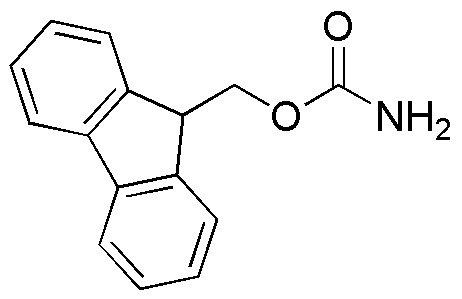N-(9-Fluorenylmethoxycarbonyl)amide is widely utilized in research focused on:
- Peptide Synthesis: This compound serves as a protective group for amino acids during peptide synthesis, enhancing the efficiency of the process and ensuring high purity of the final product.
- Drug Development: It is used in the development of pharmaceuticals, particularly in the design of prodrugs that improve solubility and bioavailability, leading to more effective treatments.
- Bioconjugation: The compound facilitates the attachment of biomolecules to surfaces or other molecules, which is crucial in creating targeted drug delivery systems and diagnostic tools.
- Research in Organic Chemistry: It plays a significant role in organic synthesis, allowing chemists to explore new reactions and develop innovative methodologies in laboratory settings.
- Polymer Chemistry: This chemical is employed in the synthesis of polymers, contributing to the creation of materials with specific properties for applications in coatings, adhesives, and more.
General Information
Properties
Safety and Regulations
Applications
N-(9-Fluorenylmethoxycarbonyl)amide is widely utilized in research focused on:
- Peptide Synthesis: This compound serves as a protective group for amino acids during peptide synthesis, enhancing the efficiency of the process and ensuring high purity of the final product.
- Drug Development: It is used in the development of pharmaceuticals, particularly in the design of prodrugs that improve solubility and bioavailability, leading to more effective treatments.
- Bioconjugation: The compound facilitates the attachment of biomolecules to surfaces or other molecules, which is crucial in creating targeted drug delivery systems and diagnostic tools.
- Research in Organic Chemistry: It plays a significant role in organic synthesis, allowing chemists to explore new reactions and develop innovative methodologies in laboratory settings.
- Polymer Chemistry: This chemical is employed in the synthesis of polymers, contributing to the creation of materials with specific properties for applications in coatings, adhesives, and more.
Documents
Safety Data Sheets (SDS)
The SDS provides comprehensive safety information on handling, storage, and disposal of the product.
Product Specification (PS)
The PS provides a comprehensive breakdown of the product’s properties, including chemical composition, physical state, purity, and storage requirements. It also details acceptable quality ranges and the product's intended applications.
Certificates of Analysis (COA)
Search for Certificates of Analysis (COA) by entering the products Lot Number. Lot and Batch Numbers can be found on a product’s label following the words ‘Lot’ or ‘Batch’.
*Catalog Number
*Lot Number
Certificates Of Origin (COO)
This COO confirms the country where the product was manufactured, and also details the materials and components used in it and whether it is derived from natural, synthetic, or other specific sources. This certificate may be required for customs, trade, and regulatory compliance.
*Catalog Number
*Lot Number
Safety Data Sheets (SDS)
The SDS provides comprehensive safety information on handling, storage, and disposal of the product.
DownloadProduct Specification (PS)
The PS provides a comprehensive breakdown of the product’s properties, including chemical composition, physical state, purity, and storage requirements. It also details acceptable quality ranges and the product's intended applications.
DownloadCertificates of Analysis (COA)
Search for Certificates of Analysis (COA) by entering the products Lot Number. Lot and Batch Numbers can be found on a product’s label following the words ‘Lot’ or ‘Batch’.
*Catalog Number
*Lot Number
Certificates Of Origin (COO)
This COO confirms the country where the product was manufactured, and also details the materials and components used in it and whether it is derived from natural, synthetic, or other specific sources. This certificate may be required for customs, trade, and regulatory compliance.


